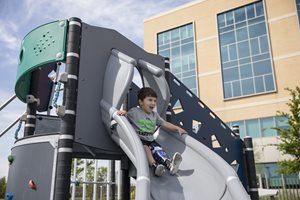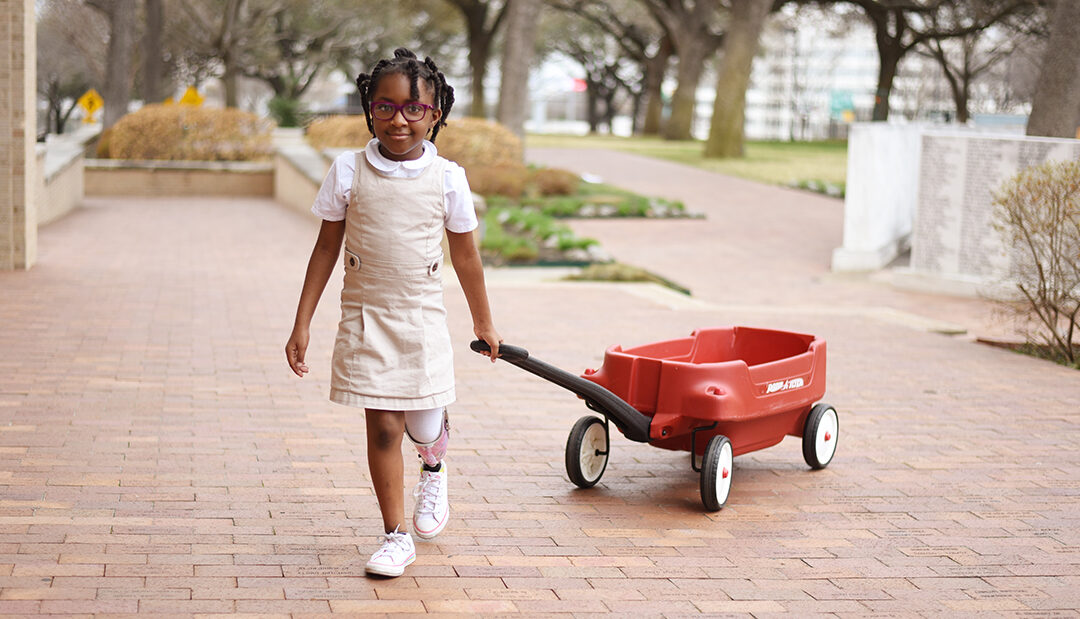There are many different words that are used to describe limb loss and limb differences. These medical terms allow patients and their families to effectively communicate with their health care provider. This glossary of words and phrases will help you learn some of the terms used to describe limb differences and limb loss.
Acquired amputation: The surgical removal of a limb(s) due to complications associated with disease or trauma.
Alignment: The position of the prosthetic socket in relation to the foot and knee.
Amputation: The surgical removal of all or part of a limb due to disease or injury.

Atrophy: A wasting away of a body part, or the decrease in size of a normally developed extremity or organ, due to a decrease in function and/or use. After amputation, for example, some of the muscles in the remaining (residual) limb often atrophy over time since they are not being used as actively as before.
Bilateral: Occurring on both sides, as in loss of both arms or both legs.
Check or test socket: A temporary socket, often transparent, made over the plaster model to aid in obtaining proper fit and function of the prosthesis.
Congenital limb deficiency: An absent, shortened or abnormal limb present at birth.
Custom fit: Fitting an individual with a device that is made from a scan or cast of the individual’s unique anatomy and fabricated according to the needs of that individual.
Extremity: A limb of the body, as in upper or lower extremity.
Gait: Referring to the manner or style of walking.
Gait training: Part of ambulatory rehabilitation, or learning how to walk, with your prosthesis or prostheses.
Lower extremity (LE): Relating to the leg.
Nylon sheath: A shear nylon interface worn close to the skin on the residual limb to reduce friction and to help wick away perspiration from the surface of the skin.
Orthosis: A external device that is used to protect, support or improve function of parts of the body that move, i.e., braces, splints, slings, etc. It can include anything from an arch support to a spinal orthosis. Orthoses is plural.
Orthotics: The profession of providing devices to support and straighten the body (orthoses).
Orthotist: A skilled professional who designs, fabricates, fits and maintains orthotic devices that are prescribed by a physician, generally as a collaboration regarding the biomechanical goals of the orthosis and the patient’s needs.
Proximal Femoral Focal Deficiency (PFFD): Proximal Femoral Focal Deficiency is a complex congenital difference in which the femur (thigh bone) is short or even mostly absent, making that leg significantly shorter than normal. PFFD includes a wide range of severity and multiple treatment options based on how big the length difference is, the child’s age and development and whether other parts of the limb or other extremities are involved.
Prosthesis/prosthetic device: An artificial limb, usually an arm or a leg, that provides a replacement for the amputated or missing limb. Prostheses is plural. Generally, the word prosthetic should be used as an adjective. If referring to an individual’s replacement artificial limb, it should be called a prosthesis not just a prosthetic.
Prosthetics: The profession of providing those with limb loss or with a limb difference (congenital anomaly) a functional and/or cosmetic restoration of missing or underdeveloped human parts.
Prosthetist: A person involved in the science and art of prosthetics; one who designs and fits artificial limbs.
Pylon: A structural part, usually a metal alloy or composite tube, that provides a relatively light weight support structure between other components of the prosthesis such as between the socket or knee unit and the foot.
Residual limb: The portion of the arm or leg remaining after an amputation, sometimes referred to as a stump or residuum.
Revision: Surgical modification of the residual limb.
Socket: Part of the prosthesis that fits around the residual limb.
Symes: a type of surgery for amputation through the ankle joint, generally retaining the heel pad so that the residual limb can tolerate more loading through that area.
Upper extremity (UE): Relating to the arm.
Van Nes (Rotationplasty): Rotationplasty is a surgical reconstruction occasionally indicated for bone tumors near the knee or for PFFD. There are many variations of this surgery, but in general the limb is shortened, and the anatomical ankle and foot are moved up to about knee level and rotated around so the heel faces forward. Once healed the person with a rotationplasty can eventually be fitted with a “below knee” prosthetic leg where the foot rests inside a custom socket and the rotated ankle is protected with metal joints and a thigh cuff. The ankle then controls the prosthesis much like a knee but with slightly less overall range of motion.

